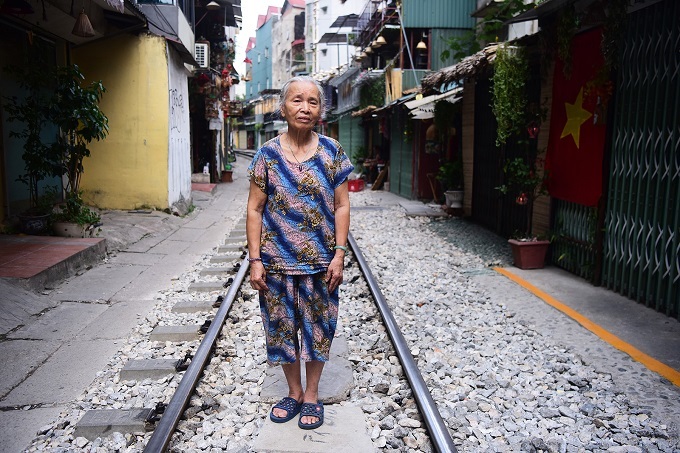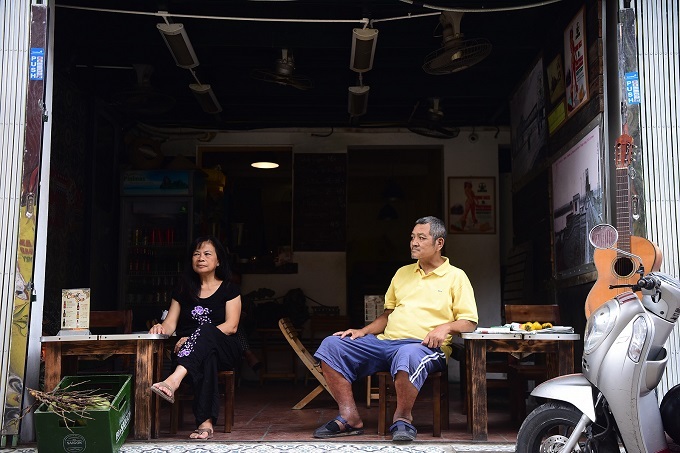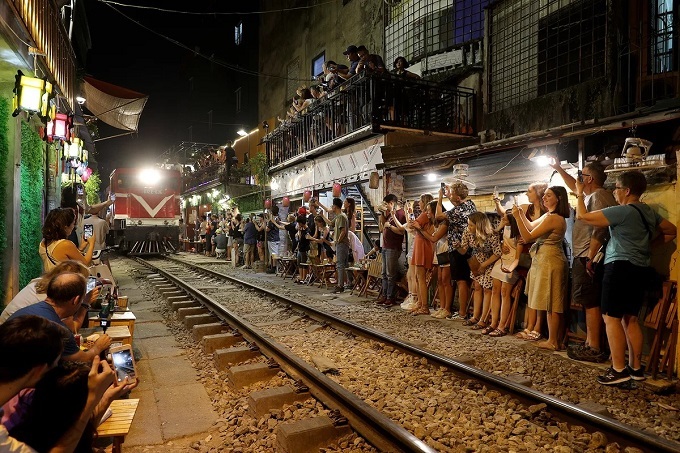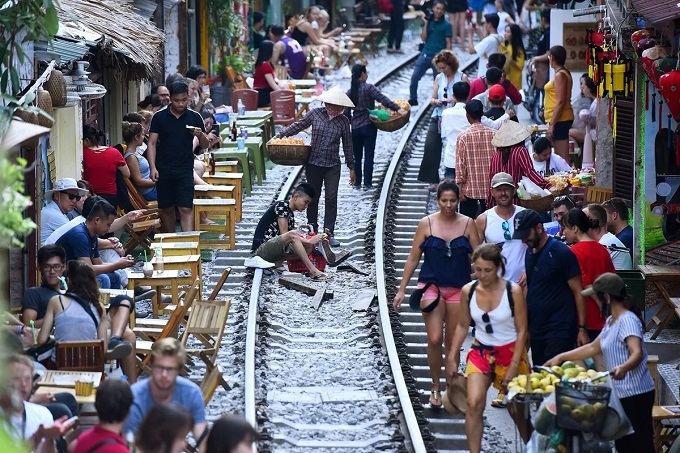Following the tracks laid by Hanoi's Train Street
Fri, 25 Oct 2019 15:34:00 | Print | Email Share:
To track the myriad tales that Hanoi's Train Street can tell, one has to reckon with different avatars it has donned over decades.
Among other things, it was once a quiet, dark, dangerous neighborhood.
Its story began soon after the trans-national railway stopped serving colonial functions in 1954, following the defeat of the French in the famous battle at Dien Bien Phu.
In 1956, the Vietnam Railway Authority built a dormitory just a few feet away on either side of the tracks to house employees working in the sector.
Starting from Tran Phu Street, the dormitory ran parallel to Phung Hung Street on a section of some two kilometers (1.24 miles) long. It consisted of mud houses just high enough that people would not bump their heads going in.
An afternoon in late 1967, Bui Thi Loan, a railway worker, took her children who were around five and three back then, to one of such house on Tran Phu Street.
The house measured around eight square meters looked onto the tracks where wild grass had almost reached her height. The most valuable asset Loan had along with her, aside from a bed, was a vacuum flask, which was a wedding's present.
Loan worked as a railway crossing guard while her husband was a train driver, usually away from home. Many other couples in the dormitory were in the same situation.
She was in charge of operating level crossings, including sounding the alarm and pulling down the barriers every time the trains were about to pass, at three different stations.
Loan worked at night. Her working day typically lasted 12 hours, and she usually wrapped up at six in the morning. Her children and those of other railway workers who took the night shift like her were more familiar with sleeping at the kindergarten established particularly for railway workers than staying with their parents.

Bui Thi Loan, 83, a resident of the Hanoi Train Street neighborhood.
Photo by VnExpress/Giang Huy.
Those days, Loan returned home every morning to see people of the Train Street staying in line to get clean water from a tank for their ablutions. Then they sat right in front of their house to brush their teeth, wash their faces, clean their throats and spat out the water right on to the tracks.
Every evening, when Loan left her house and walked to the stations for work, she always had to narrow her eyes because of the smoke coming from stoves where locals burned honeycomb charcoal briquettes to cook their dinner just next to the tracks.
Quite often, she also saw old men in the neighborhood sitting together, drinking tea and smoking tobacco pipes quickly stand up and pull their tables and chairs away as a train passed, and around 10 minutes after it had gone, return to the old spots and continue drinking their tea, smoking and making conversations.
When the Vietnam War (1955-1975) entered into is fiercest phase and a majority of Hanoi was evacuated, the railway workers had to stay put, because the trains were still in service.
Those days, Loan spent her daytime digging a vault so that she and her children could take shelter when the bombers came. She also had to take her children to the stations with her while working at night because the kindergarten had been temporarily shut down.
Then the war finally came to an end and the north and south were reunited.
In 1979, 23-year-old Mai was a worker at the Rang Dong Light Source and Vacuum Flask Joint Stock Company with an acceptable income that could ensure her a stable life.
That year, Mai decided to get married. But, when her friends learned that she would tie the knot with a worker in charge of inspecting the railway tracks, they could not hide their disappointment.
It was just not worth it for Mai, they said. Given her age and her career, Mai could "marry anyone," why should it be a worker living along the tracks in a neighborhood virtually considered a slum of the capital city?
The husband, Dung, lived there with his four-member family. As per tradition, Mai came to live with her husband’s family after the wedding.
With the newly-wedded couple, the small house had to be modified to add a garret to give them space. The first night at Dung's house, Mai could not sleep, partly because the bed would vibrate nonstop every time there was a train running by.
The next morning, when she woke up, Mai was frightened and disgusted. The place stank of urine and there was excrement that train passengers discarded onto the tracks at night.
But she had no choice but to accept her surroundings and brave that scene every morning she went to work, because that was what you did once you were married. You moved on.
Then Vietnam entered the subsidy period from 1976 for about 10 years – a period of scarcity, rationing and waiting for handouts from the government.
As the business was slow for the railway sector, Dung could not earn much and did not have trains to drive as frequently as did before. He decided to quit his job and moved to the Rang Dong company to work with his wife.
Many of their former colleagues in the railway industry did the same, switching to earning a living by driving cyclos, working as security guards, or selling essential products at home.
Then came the economic renovation process Doi Moi, which was launched in 1986. As Vietnam opened its doors and shifted to a market-oriented economy, things changed rapidly and being a worker at Rang Dong was no longer a dream job.

Mai and her husband Dung sit in their coffee shop in front of
their house on Hanoi`s Train Street. Photo by VnExpress/Giang Huy.
Dung saved up money to buy a motorbike and quit his Rang Dong job. Three years later, Mai followed suit, becoming a street vendor selling noodle soup from her bamboo shoulder poles on the streets of Hanoi.
Ugly underbelly
In the 90s, Mai still opened her door to see and smell human waste but there was a dangerous new addition on the tracks: drug needles.
The Train Street section had become a criminal hub and no outsider dared to step in when it got dark, not even police in charge of patrolling the area. Residents were afraid to step out at night, too. Children were strictly banned from going outside to play.
The dim light from the storm lamp inside their houses and from the trains running through at night were the only sources of light in this area those days. Residents still recall opening their doors at night and seeing young men lying on the tracks, injecting heroin together.
It was not a good time for people on the Train Street and they lived in the hope of better living conditions elsewhere.
Many state delegations were sent to the neighborhood to make measurements and collect data for the plan to expand the tracks and relocate families in the areas. The residents signed documents accepting the expansion project in the hope of getting a more decent place to live.
But years later, nothing had changed, and a new millennium (2000) had dawned. They still lived close to the tracks. The trains still ran past, rattling their homes each time, and relocation remained a dream.
Many families living on the Train Street have two or three generations living under the same roof. Some people were jobless, others had no retirement pension. The area had gone from being a slum to a slum and occasional drug den.
Waiting to happen
The fortunes of the Train Street changed in 2014, when the arresting sight of a train running right through the heart of a densely packed residential area was published in foreign newspapers and magazines, especially in the U.S and the U.K.
Overnight, the Train Street achieved stardom, and a must-visit tourist hotspot, not only for foreigners, but also for locals who began seeing the place with new eyes.

Tourists take pictures of a train passing the Train Street in September 2019.
Photo by VnExpress/Giang Huy.
Without any official prodding, residents of the train street spruced up the place to make visitors feel welcome. They removed all the wild grass along the tracks, picked up all the trash, and ensured they stayed clean. They also renovated the façade of their houses and built a sewage system to ensure that no wastewater came anywhere near the tracks.
Soon, the residents were in business, and coffee shops and restaurants mushroomed, giving visitors the chance to sit down and relax in the must unusual setting, and enjoy the sight of a train passing by at close quarters.
Mai and Dung were in on the game. They had their walls repainted and decorated. Dung, the former train driver, brought home a broken door and an old passenger chair to give their coffee shop the look of a train carriage.
Loan, the railway worker who had to take her kids along to work during her night shifts, was thrilled to see her son's coffee shop serve several hundred customers each day.
After decades of struggle, finally, things were looking up.

Visitors and vendors on the Train Street of Hanoi before the city shut
the place down on October 10, 2019. Photo by VnExpress Giang Huy.
It was too good to last, however.
In early October, as safety considerations gained urgency, Hanoi authorities began shutting down the makeshift coffee shops along the Train Street.
The safety issue was particularly highlighted on October 6 when a train had to apply its emergency brake in the face of visitors crowding the section.
Before the incident, the Ministry of Transport had already ordered the city to take urgent measures to remove street vendors and illegal businesses that had sprung up along both sides of the tracks that form the Train Street.
Local authorities had been ordered to "strictly handle" coffee shop owners violating rules.
Ha Van Sieu, deputy chairman of the Vietnam National Administration of Tourism, said at a press meet later that railway coffee shops along the Hanoi Train Street attracted large crowds of locals and foreign tourists alike, but these were "spontaneous" and "violated safety regulations."
On October 10, Hanoi officially shut down all makeshift coffee shops and set up barriers preventing tourists from going into and gathering on the Train Street.
End of the line?
Today, the Train Street is deserted and the residents glum, and visitors look wistfully at it from barriers placed at rain crossings.
Loan, 83, feels cheated.
She had become a railway worker when she was 18. It was she and her colleagues who built the very first tracks for the northern trail of Vietnam. With bare hands, Loan and others opened roads so that people could lay tracks.
"Railway workers got no salaries those days. We were given rice and vegetables, drank water from the streams. But we cried tears of pride and happiness on hearing the sound of train horns. We knew the trains were running because of our work.
Dung rarely talks these days. He sits quietly in front of his house, which used to be a coffee shop until just a few days ago, and reads the newspaper. Sometimes he glances at the barriers and the police, and his eyes follow the steps of visitors that police have just sent away.
But, after a lifetime of service to the railways, Loan has a question that no one has apparently bothered to ask the authorities.
"You say the operation of coffee shops and the gathering of people here pose a threat for the railway safety.
"Then why did you send railway workers to live here in the first place?"
By: Hoang Phuong, Thanh Lam/Vnexpress
---------------------------------------------
Same category News :













